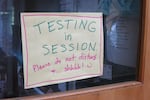
A computer lab at Westview High School.
Rob Manning/OPB
Oregon students in third grade through high school took standardized tests last spring that are tougher and longer than they've seen in the past. The results of these tests of -- called Smarter Balanced -- were released on Thursday. Here are key lessons to take away:
1. Waiver Lowers The Stakes For Schools
Other than a limited field test in 2014, these were Oregon's first go at the new tests of Common Core standards. The test results were, for the first time, supposed to count toward school and district ratings.
That's not going to happen this school year, thanks to a waiver granted earlier in 2015 by the U. S. Department of Education. Oregon education officials say that because the new test is completely different from the old Oregon Assessment of Knowledge and Skills exams, the two can't be compared.
2. New Exam, Familiar Achievement Gap
Okay, it's a new exam - we get that. But the results look depressingly familiar. Students of color and low-income students scored substantially lower than their white counterparts.
The differences are clear in third grade. On the reading exams? Just 27.6 percent of black students were proficient readers, and 26.9 percent of Hispanic students. Only 33.4 percent of low-income students read proficiently. The figure for white third graders, regardless of income: 52.4 percent.
Sure, it's not good that about half of white students are not reading proficiently, according to the new test. But this isn't new.
The old OAKS exam's results from 2014 for reading results across all grade levels showed that 77 percent of white students scored "proficient," while only 51 percent of black students and 53 percent of Hispanic students did so.
The proficiency rate on math at third grade is in the mid-20 percent range for Hispanic and black students statewide, versus over 50 percent for white students. There's a roughly 25 percentage point difference through high school.
"The gap persists," said Salam Noor, deputy superintendent of public instruction for Oregon. He said that whether reviewing the old test scores or the new ones, “It reinforces the notion that we do have an achievement gap. And although in some categories, we saw improvement, but they're not significant to suggest that the gap is actually closing."
Overall passing rates, percentage-wise, were better on the old tests, but that's perhaps to be expected with the new, intentionally more rigorous, set of exams.
3. Oregon Has A Math Problem
State officials are relieved to see that passing rates on the Smarter Balanced exams are higher than they anticipated based on the 2014 "field test." But they're still concerned about math.
On reading tests, passing rates mostly improved from grade level to grade level, with high school students scoring better than those in grade schools. But the opposite trend persisted in math, which high-school students doing worse than grade-school on the tests.

Oregon's standardized testing scores in 2017 continued to fall below expectations. Less than 50 percent of students who took the tests passed the math portion, with 53 percent passing the reading exam.
Rob Manning / OPB
Here's how many students passed reading by grade level: third grade: 45.6 percent; fourth: 49 percent; fifth: 53.6 percent; sixth: 52.7 percent; seventh: 55.5 percent; eighth: 57 percent; high school: 67.2 percent.
Here's how they did on math: third grade: 45.6 percent passed; fourth: 43.7 percent; fifth: 40.8 percent; sixth: 38.1 percent; seventh: 42.6 percent, eighth: 42.9 percent; high school: 30.5 percent.
Part of what's going on is that the math assessment requires more complex thinking and less simple computation under the Common Core State Standards than on the old exam. It's a big change. But it's been five years since Oregon's State Board of Education adopted the Common Core, so, you might expect schools and students to be better prepared for the long-form math questions on the Smarter Balanced tests.
"I think math continues to be a challenge, regardless of what assessment we use," said Noor, of Oregon Department of Education. "We've started some conversations as a state about 'what do we do to help build our capacity to improve math instruction and math performance'."
Noor said that Oregon's growing focus on science, technology, engineering and math - dubbed "STEM" - is one way the state is trying to make math more relevant and engaging to students. The state's Career Technical Education program is another.
4. As Students Opt-Out, Participation Rates Become A Challenge
Oregon barely met the federal participation target for the state. Just over 95 percent of students took the reading and math tests. The minimum required is 94.5 percent. The state fell short of the target for two sub-groups, black students and students in special education.
Twenty-one Oregon districts did not reach the participation target, including Portland, Eugene and Lake Oswego schools. There were low participation rates in rural areas, too, such as Estacada, Frenchglen, Douglas County and Willamina.
Over the summer, the Oregon Department of Education wrote to school districts warning that federal funds could be in jeopardy if participation rates fell below the federal requirement. It was too late to change anything for last spring's tests, so it served more as a warning shot for next spring.
State education spokeswoman Crystal Greene said there's been no indication so far that the feds will withhold any money, but she said the U. S. Department of Education is watching Oregon closely.
Keeping participation rates high could prove difficult for school officials.
Skepticism of standardized tests gave rise to a new Oregon law, passed in the 2015 legislative session, requiring schools to communicate more with parents about the test, and providing clearer guidance on what it takes to "opt out" of exams.
Federal officials have said that the state's law is tantamount to discouraging parents and students from taking the tests.
"We want to encourage districts to engage parents and students relative to the assessment itself, the purpose of the assessment," Noor said. "I think it's important that we tie it to the learning that is actually happening every day in classrooms throughout the school year, and what this assessment actually measures."
But Oregon officials don't see the new Smarter Balanced exam as the "be-all, end-all," either. They are backing what Noor calls a "balanced assessment" approach. It's based on work from a joint task force led by teachers and education officials. Its recommendation is to lean less on end-of-year exams like Smarter Balanced, and emphasize formative and interim exams -- think "quizzes" and "mid-terms," rather than "final exams."
The feeling is those kinds of assessment actually help teachers - and students - find out what they still need to know, with time to do something about it.
